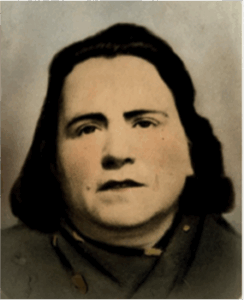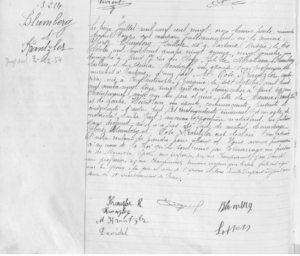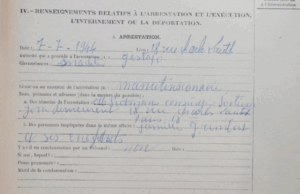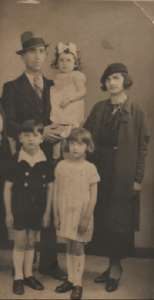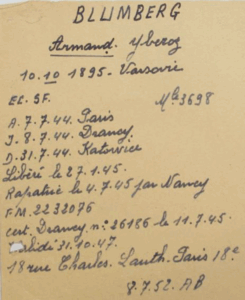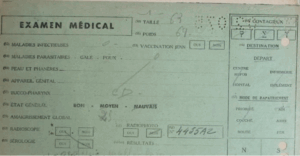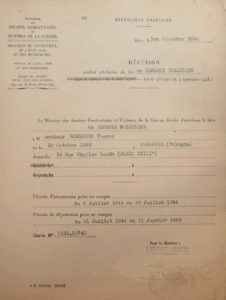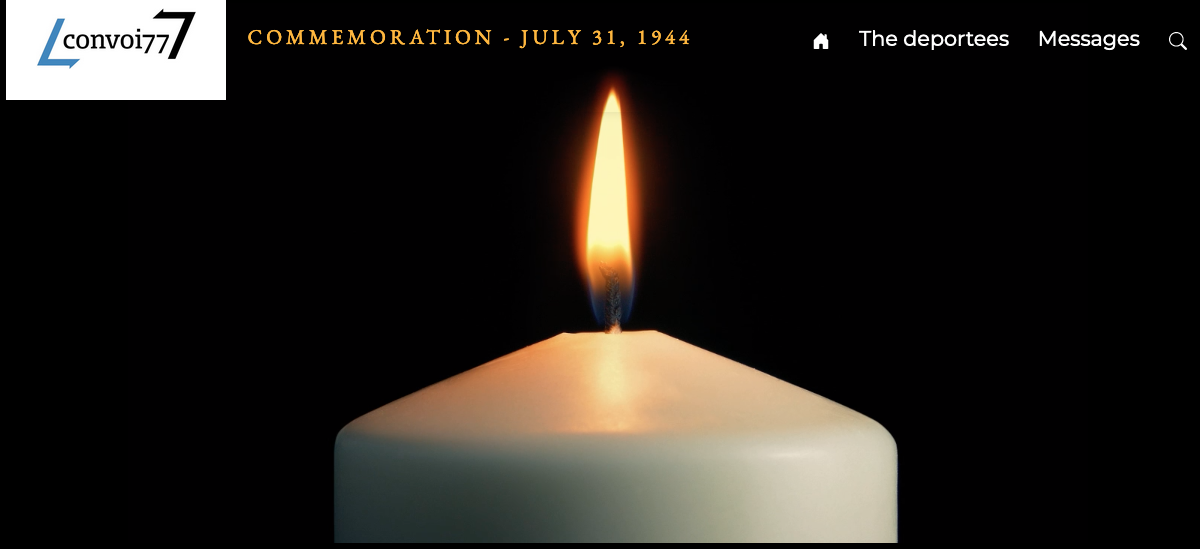Ybersz Armand BLUMBERG
Photo of Armand Blumberg. Source: © family photograph belonging to Lionel Levha, Madeleine Blumberg’s son
Ybersz Blumberg was born on October 10, 1895 in Warsaw, Poland. HIs parents were Abraham and Anna Blumberg. They and their family emigrated to France and set up home in Paris in 1903 or 1904. That was probably also when Ybersz began using the French version of his name, Armand. He was naturalized as a French citizen by decree on March 6, 1929.
Source: File on Armand Blumberg © Victims of Contemporary Conflicts Archives Division of the French Ministry of Defense Historical Service, in Caen, Dossier n°21P71147374930
In 1928, when his son André was born, André stated that he was a tailor by trade, but other records suggest that he also worked in a warehouse worker and as a secondhand dealer.
On July 13, 1920, in Paris, he married Rose Krantzler, who was born on October 7, 1896 in Constantinople, in Turkey.
Rose Blumberg née Krantzler
Source: © family photograph belonging to Lionel Levha, Madeleine Blumberg’s son
The witnesses at the wedding were Minisha Lipson and José Davidel, both of whom lived in the same street as the Krantzler family.
Marriage certificate
Source: File on Armand Blumberg © Paris archives
The couple went on to have six children. The fact that they gave them all French names shows that they were keen to integrate into French society:
- Anna Léone, born in 1922
- Madeleine, born in 1926
- André, born in 1928
- Serge, born in 1930
- Simone, born in 1932
- Alain Louis, born in 1944
Alain is only member of the family of whom we have no photos, because he was born in Drancy camp and murdered in Auschwitz-Birkenau when he was just two weeks old.
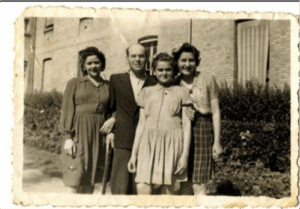
Armand and his daughters.
From left to right, Anna, Armand, Simone and Madeleine
Source: family photograph belonging to Lionel Levha, Madeleine Blumberg’s son
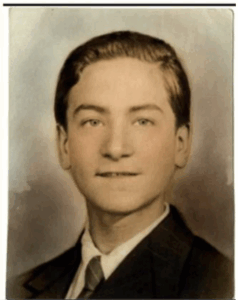
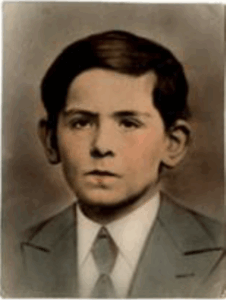
André and Serge
Source: © family photograph belonging to Lionel Levha
According to his daughter Madeleine, Armand was a strict father, but she had a very happy childhood nevertheless.
After living for some time at 17 rue de Clignancourt in the 18th district, the Blumbergs moved to a nearby apartment at 18 rue Charles-Lauth, which was in a low-cost house complex built in 1935. The 18th district was home to a large Jewish population, many of them low -income families.
The Blumberg family’s neighbors included the Grinberg and Sadicaris families, who were also arrested and subsequently deported on Convoy 77.
In accordance with legislation ordered by the Germans, the Grinberg family registered themselves as Jews at their local police station in the fall of 1940, and soon after that, they were required to wear the yellow star. In late 1943, Armand and his wife decided to send their two youngest children, Serge and Simonne, to stay with a Mrs. Boulland and a Miss Simon on a farm (L’Herbage in Couterne) in the Loiret department. Life in Paris had become so difficult that they felt it better to try to save the children by sending them to stay in the country.
Simone and Serge
Source: © family photograph belonging to Lionel Levha
However, in January 1944, financial constraints and a heavy workload left the two women with no choice but to keep Simone with them (which ultimately saved her life: she died in Paris in 1933) but send Serge back to Paris.
The arrest
The Blumberg, Grinberg (spelled Grimberg at the Shoah Memorial, but Grinberg on the Convoy 77 deportation list) and Sadicaris families all lived at 18 Rue Charles Lauth. The building’s concierge, Anna Putmans, later testified to having witnessed the arrest of the Blumbergs and the Grinbergs.
Arrest record
Source: File on Armand Blumberg © Victims of Contemporary Conflicts Archives Division of the French Ministry of Defense Historical Service, in Caen, Dossier n°21P71147374930
The Grinberg family
Source: File on Rivbaka Grinberg © Shoah Memorial, Paris
Nahama Sadicaris and his family
Source: Convoy 77 website , biography written by Karine, Nahama Sadicaris’ granddaughter
Nahama Sadicaris was arrested in a café on Friday, July 7, 1944. The following evening, Saturday, July 8, the Gestapo descended on the apartment building and rounded up the Grinbergs (Esther Spatz, the mother, and three of the six children, Rebeka/Renée, Maurice, and Monique. The father, Shil, had been deported on Convoy 3 on June 22, 1942) and the Blumbergs.
Nahama’s granddaughter, Karine, who wrote his biography, said that when he failed to come home that Friday evening, the rest of the Sadicaris family decided not to risk staying in the apartment. They sent the four older children to stay in the UGIF (Union Générale des Israélites de France, or General Union of French Jews) home on rue Secrétan. Estréa, Nahama’s wife, and her one-year-old daughter Hélène were kept hidden by a neighbor, Mrs. Maerten, who lived on the ground floor of their building.
She also said Nahama and Ybersz Armand got into a fight while they were in Drancy. The quarrel was probably about the circumstances surrounding the arrest of the family. However, we have no further insight into the matter because Mr. Blumberg, an Auschwitz survivor later said, “Nahama Sadicaris, I never want to hear his name again!”
Ybersz Armand, his pregnant wife Rose, and their four children, Anna, Madeleine, André and Serge, were taken to Drancy, where they stayed for 23 days.
While they were there, on July 17, Rose gave birth to a baby boy, Alain Louis.
Deportation to Auschwitz-Birkenau
On July 31, 1944, the Blumberg family was deported on Convoy 77 to Auschwitz-Birkenau. The baby, Alain-Louis, was transported in a little box lined with muslin. The family traveled together in an overcrowded cattle car (there were around 60 people per car), its floor strewn with straw, with no hygiene facilities and barely any drinking water, even though it was very hot that July.
When the train arrived in Birkenau during the night of August 3-4, 1944, Rose and little Alain-Louis were immediately put on a truck that took them to the gas chambers, where they were murdered. Armand, Madeleine, Anna, Serge and André were all selected to stay in the camp to work.
Armand had the number B. 3698 tattooed on his forearm (André was number B. 3687).
The fact that the industrial city of Katowice is listed on this handwritten note implies that Armand worked in the Auschwitz-Birkenau sub-camp of the same name. This tiny “kommando” made up of just ten prisoners was tasked with building an air-raid shelter and barracks for the Gestapo. His name is also on “transport” list dated December 8, 1945, but is crossed out.
An undated record written in German states that he was suffering from lithiasis (formation of a calculus, or stone) and bronchitis with emphysema.
Source: File on Armand Blumberg © Victims of Contemporary Conflicts Archives Division of the French Ministry of Defense Historical Service, in Caen, Dossier n°21P71147374930
There is a record of Serge being held in the Sachsenhausen camp in December 1944. André was admitted to the Auschwitz infirmary, the “revier”, in January 1945, shortly before the camp was liberated. We found no further trace of him after that.
Armand, Anna and Madeleine all survived their time in the camps.
The return to France
Armand was still in Auschwitz when the Soviet army liberated the camp on January 27, 1945, but he did not return to France until July 4, 1945, when he was repatriated to Nancy, now in the Moselle department. His name is on a list of French Jews from Auschwitz who were admitted to hospital on March 7, 1945, and a list of survivors reveals that his work involved “ironing.” He was probably left behind when the Nazis evacuated the camp due to his poor health. His medical report reveals that he had lost 55 pounds in weight, was suffering from malleolar edema, i.e., swollen ankles, and had a wound on his right ring finger. He is listed in the Bichat Hospital admission records as suffering from acute nephritis.
Two other records from the Arolsen Archives also state that Ybersz Armand suffered from bronchitis, but no dates are listed.
Source: File on Armand Blumberg © Arolsen Archives, ref. 534538_1.1.2.1
“Whale lithiasis” means gallstones
“Emphysematous bronchitis” is chronic lung condition involving bronchitis and emphysema
Source: File on Armand Blumberg © Victims of Contemporary Conflicts Archives Division of the French Ministry of Defense Historical Service, in Caen, Dossier n°21P71147374930
Source: File on Armand Blumberg © Arolsen archives, ref. 534538_1.1.2.1
Source: File on Armand Blumberg © Victims of Contemporary Conflicts Archives Division of the French Ministry of Defense Historical Service, in Caen, Dossier n°21P71147374930
Armand eventually moved back to the apartment at 18 rue Charles-Lauth, and stayed there for the rest of his life. On September 12, 1947, a Mrs. Andrée Korkos, who also lived there, testified to having witnessed him having been arrested on July 7, 1944.
Rebuilding his life
The post-war years were difficult, but Armand managed to make a new life for himself, and went on to marry a woman called Simone Louiset.
He worked as a second-hand dealer and ran a stall at a flea market in Clignancourt. It may have been at the Paul-Bert market, which was set up in 1946, and where stalls were allocated as compensation for property confiscated during the Second World War.
Armand was granted the status of political deportee on December 1, 1954, in recognition of the fact that he had been deported because he was a Jew. He received his political deportee card, also known as a “blue” card, on December 22, 1954.
He secretly kept in touch with his daughter Madeleine. According to her son, Lionel. Levha, his mother said that the entire family had died in Auschwitz. His grandchildren were not even aware that their grandfather had survived until a long time later.
Armand died in Paris in December 1964. He was 69 years old.
We would like to thank Mr. Lionel Levha, Madeleine Blumberg’s son and Armand’s grandson, for sharing with us his memories of his mother and for allowing us to publish the family photographs.
We would also like to thank Muriel Baude, a teacher at St Charles High School in St Pierre, Réunion, who began working on this biography in 2018, and a group of 12th-grade students from Camille Guérin High School in Poitiers who also contributed to the research.


 Français
Français Polski
Polski

